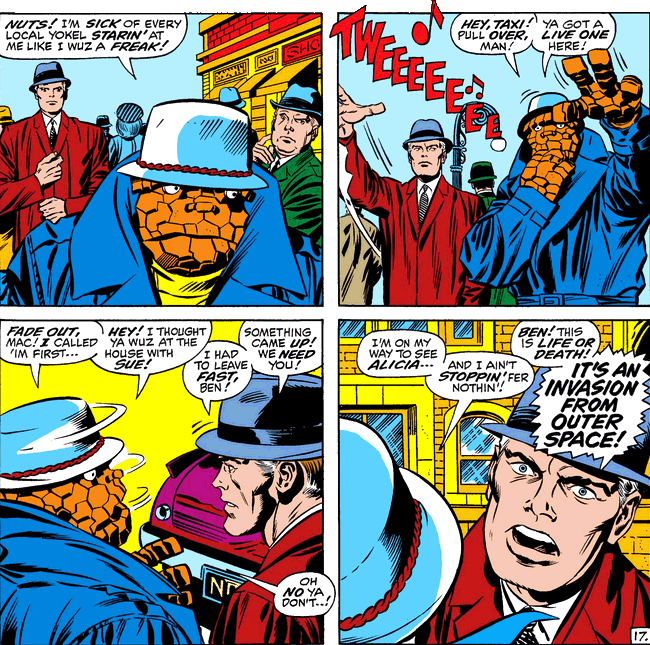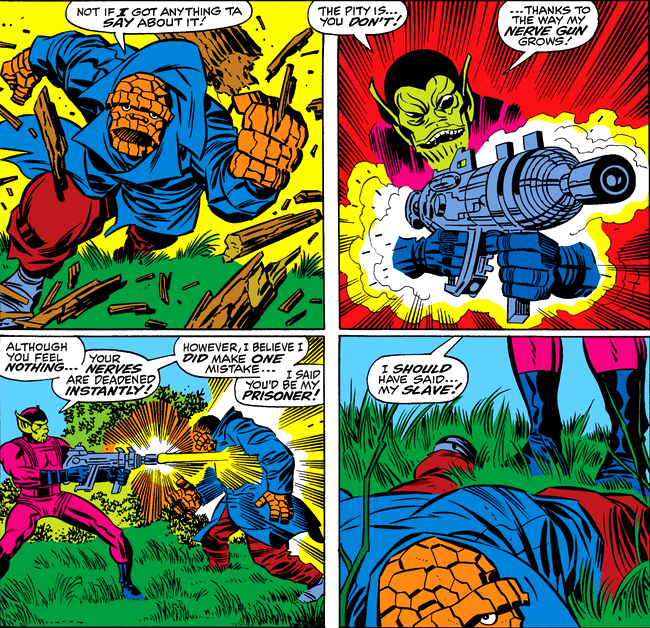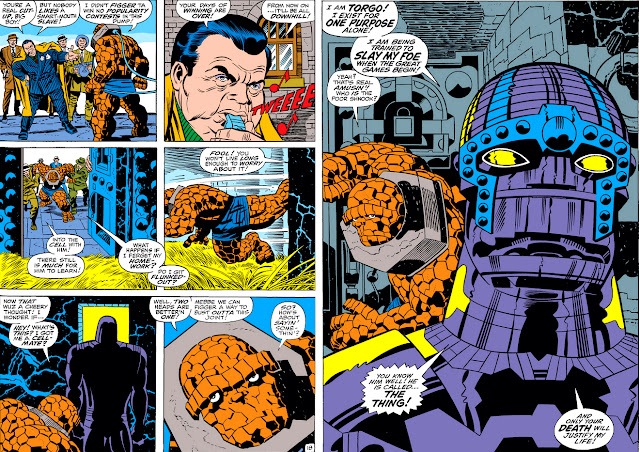Although none of us were likely aware of it at the time, a four-part story arc which played out from September to December of 1969 in the pages of Fantastic Four would be the last multi-issue storyline for the book from artist Jack Kirby--and you had only to look at its collective covers to realize that it was something of a feast for the imagination.
By this time, Kirby and his family were living in Irvine, CA--still doing a flurry of work for Marvel, though discontented with his lack of a contract or residuals (e.g., not being compensated for the art he was providing for Marvelmania, the fan club which had spun off from the defunct MMMS). After completing a three-part story in mid-1970 for his other regular title, Mighty Thor, Kirby would turn in what became his final work for that book which would appear in August of that year. But it was his work on the premiere issues of Amazing Adventures and Astonishing Tales, as well as fill-in work for the soon-to-be-cancelled Silver Surfer title, which would coincide with the disappointment he felt at failing to secure an equitable contract with the company, marking an end to his distinguished career at Marvel Comics.
Yet it's the FF tale we throw the spotlight on here, published just over a year and a half after the airing of "A Piece Of The Action," a Star Trek episode with which it shares certain elements--specifically, a planet whose population has patterned their own development from America's gangster culture of the 1920s. The story also takes the opportunity to focus on one member of the FF in particular--Ben Grimm, the Thing, who is targeted by a foe whose power is ideal for luring an unsuspecting victim into a trap.
Having taken a taxi to a secluded area in the countryside, there's little doubt that "Reed" is about to make his move on the Thing--and taking a glance at one of this story's covers, the nature of this enemy is all too clear. The story has also made a point of showing earlier that he's meticulously prepared well in order to capture this member of the FF--yet the question remains, why?
With the rest of the FF none the wiser (at least initially), Kirby begins to assemble the pieces of an unusual and almost unbelievable premise which not only involves an entire planet of Skulls choosing to live as humans from Earth's past, but also reveals the Thing having fallen into the hands of a "slaver" Skrull--one who means to sell him to Skrull-gangsters whose practice is to use such off-worlders in gladiatorial-themed games held to settle territorial disputes.
It's not terribly surprising to discover that the Skrulls are proficient in the practice of enslavement of other species--though in this case not as labor, but as fighters who will be trained to battle to the death. It's a curious balance which Kirby and writer Stan Lee seek to strike here, side-stepping what would be normal assumptions for any FF reader to make: First, that the Skrulls, who have such disdain for Earth and its race and who outright despise the Fantastic Four, would be content with those inhabiting Kral to take on human form, human lives, and human customs... and secondly, the fact that the Skrull Emperor--presumably having received reports of a member of the FF being taken to Kral--hasn't dispatched a ship to seize the Thing in spite of what these Skrull-humans have in mind for him. To proceed as if neither of these concerns would be raised seems nothing short of astonishing.
In addition, why would Skrull slavers cater to the whims of these Kralians--to the point of bartering with them for payment of services rendered? Nor do the Skrulls barter for what we would consider conventional reimbursement from the denizens of Kral, but rather, power stones ("perfect" power stones, we learn, which we can assume indicates their rarity and value), on which these Skrull-humans appear to hold a monopoly. While it's interesting to presume that the Skrulls have such arrangements with other worlds in their empire, our impression of the Skrulls has usually been consistent with the assumption that they are of one mind, rather than clusters of independent governments engaged in such commerce. (It's possible that the Skrull slavers have an under-the-table arrangement with the Kralians. Who knows.)
As for how these particular Skrulls came to adopt their 1920s/'30s way of life, that, too, will parallel the Trek episode, though with a Skrull twist.
As we've seen, the Kralians are not averse to emulating a bygone Earth era of organized crime and submachine gun "hits" while still making use of their own achievements in advanced science, in spite of the limitations inherent in living a primitive fad they've embraced. The "system" they've put in place--to let their enslaved fighters settle their disputes--would appear to be designed to avoid the potential destruction of open warfare; yet how they've managed to adhere to their "way of life" while still making allowances for such weaponry to be used in aggressive operations like slave-stealing is anyone's guess.
Once processed, the Thing's next stop is the slave training center--run by the no-nonsense Napoleon G. Robberson (who will appear familiar to those of you who are fans of classic gangster films) whose role is to indoctrinate new slaves to what's expected of them. Unfortunately, as Ben discovers, what's waiting for him as a slave may mean his death at the hands of his opponent when the "Great Games" take place.
And so the "training" begins, which appears to involve nothing more than using brief combat duels with different pair-ups to "be sure [the fighters] battle like demons" while also exposing the fighters to the various tactics and capabilities of those they might face. Of course, our two fighters already know who's on the bill: Boss Barker's fighter, the Thing, will battle Torgo, property of Lippy Louie, making this contest more like a one-round boxing match rather than Earth gladiators fighting in succession to eventually be awarded the title of Champion. With one notable difference, of course--the match is fought to the death.
At last, then, the day of the Games arrives. And though the stakes involved consist of entire territories held by those who have a fighter representing their interests, the Games have come to represent a highly regarded contest for those in a position of power on Kral--and so Lee provides a level of decorum suitable to the era of distrust and underhandedness which signified the world of organized crime nearly one-hundred Earth years ago.
As for the Thing, this story has gone to some lengths to establish why the efforts of this most impatient member of the Fantastic Four to lash out at his captors have met with failure--Skrull technology which has up until now included a strength-sapping nerve collar (funny how Torgo wasn't given one), "brain-blast" hand weapons which debilitate their victim, and a hypno-device in his cell which conditions him to refrain from taking such action should he turn against his jailers (mostly serving as a backup for the other measures). But it's only when his match is imminent that Ben learns of the mostly deadly device designed to hold the slaves in check.
Meanwhile, the rest of the FF (minus Sue, who's ordered by Reed to stay behind as "the mother of [his] son") have succeeded in picking up Ben's trail and reaching Kral with the aid of a Skrull saucer they took possession of in their first battle with the Skrulls*--their arrival a timely one, as Torgo, more familiar with the Skrull weaponry being used in the arena, has the Thing at a disadvantage and prepares to deliver the killing blow. But once Crystal destroys the device being used to compel the slaves' cooperation as contestants in the arena, Torgo is ready and willing to seize the day and rally the rest of the slaves to pay back their masters in full. (So much for that hypno-glow, eh?)
*I don't remember the FF hauling a saucer back to the Baxter Building after that encounter, let alone the rocket-powered water tower the Skrulls used in that issue--but who am I to argue with an Editor's note that claims otherwise.
The FF take the chaos breaking out on the scene as their cue to return to their water tower saucer and lift off for Earth. Ideally, whatever happened on Kral as a result of the insurrection would have been sufficiently fierce for the Kralians to scrap this arrangement and return to a more conventional role as a planet of the Skrull empire--but in this post's follow-up, we'll learn that we haven't seen the last of either the Great Games, or Torgo, or Boss Barker.























9 comments:
As a kid who grew up watching Star Trek reruns, and was totally familiar with the ST gangster episode, this storyline was a bit of a slog to get thru. You could tell that from somewhere around issue 71 of FF, Kirby was starting to phone it in, no new characters of note and a lot of recycled plots.
Yoyo
Well, thats because he was holding stuff back. Kirby came up with a lot of the Fourth World stuff in this period, but he wasn't about to give it all away to Marvel for nothing.
So instead of new stuff in the FF like the Inhumans, Surfer, Panther etc you get to find out what Jack had been watching on tv - The Prisoner as well as Star Trek - return bouts with the Mole Man and Dr Doom, and stories that are an issue or two too long.
All the same though, even phoning it in Kirby still did pretty great work - he can't help but come up with "something of a feast for the imagination" even when he's recycling somebody else's ideas - and I like his FF right to the end.
Thanks Comicsfan - I enjoyed revisiting these issues.
-sean
In my youth, I was a DC kid. Via a volunteer gig my mom had, I ended up with a random handful of Marvel Comics, which were fascinatingly mysterious. I studied issue #92 endlessly, trying to make sense of things, delighting in the bold action, and the Thing's wisecracks. How did the mighty Thing get captured?? How was he going to escape and would Earth survive?? High-tension stuff!
It was many years later that I finally read the bracketing issues and was hugely underwhelmed. A feeble story surrounding this one great issue.
Drawing gangsters from the movies (and reality?) of his childhood really seemed to be Kirby's forte.
Going by the look of it, the saucer is actually that of Kurrgo, Master Of Planet X, in FF #7. I assume it was Stan's mistake as he scripted the issue, though it's possible Jack made the error in his margin notes.
Kid, that is an excellent explanation for how the FF came into possession of their "Skrull" saucer--works for me, pal. (You know, in the old days, you would've rated a helluva no-prize for that level of sleuthing. :) )
Yoyo, I would disagree with you in that I felt there were actually a number of issues from 1968 until the end of Jack Kirby's run that comprised excellent storytelling on his part; if anything, I would say there was a lapse on writer Stan Lee's part, particularly segments of the stories featuring Galactus and Dr. Doom where Lee's sparse dialog fell far short of the mark or simply didn't step up and meet the story halfway. That said, there were also examples to the contrary--e.g., the FF's battle with the Wizard which added a level of drama to Ben Grimm regaining his humanity, followed up with his decision to sacrifice his new life for the sake of Alicia Masters.
Murray, I readily agree with you about Kirby's preferred subject matter, though I would broaden that a bit and suggest that he took a shining to other aspects of the time, as well. If you can find it, you might enjoy a splendid "coffee table" book which was published in 2002 from the Comics Journal library which focused on Kirby's work--it's quite comprehensive, and also features the Journal's extensive interviews with Kirby from 1969, 1971 and 1989.
sean, you raise a good point in your mention of Kirby at times taking "an issue or two too long" with a story. In the Mole Man story, in particular, I felt the initial suspense of the new house was drawn out overlong, with not much offered in the way of a resolution; and in the Doom story, spending four issues only to reach a stalemate with Doom was asking too much of readers.
Skrull Edward G. Robinson: "Nobody likes a smart-mouth slave!"
The Thing: "I didn't figger ta win no popularity contests in this dump."
I love that line. That's classic Ben Grimm right there.
Yeah, I get that it's a rip-off of Star Trek, and the art is kinda wobbly in places, but I still enjoyed this arc immensely.
I think putting the Thing in gladiatorial games on a Skrull gangster planet is something you HAVE TO DO as a comic book writer, if the idea occurs to you.
It would be almost a crime not to, quite frankly.
M.P.
I dug out the issues and enjoyed a re-(re)-read.
Skrull Emperor "The wretched Fantastic Four must be crushed! Get the best scientists! Marshal any resource! This proposed 'Super Skrull' is the only way!"
Alternate Timeline: Aide to Emperor "Or we could just hire any freelancer from the slaver guild to deal with the primitives.
In the main timeline, no doubt the scientists keen to try their Super Skrull Hypothesis had this Aide rubbed out before he made his suggestion...
I agree with other comments that this latter period of Kirby's tenure at Marvel shows him being lazy, not wanting to give anything creative to Marvel at this point. Kirby can still be entertaining, but it's quite a let down from his previous work. As mentioned, there is good reason for Kirby to be so. I don't blame him saving his ideas for later. But it is a disappointment as a Marvel fan.
While I think the Prohibition gangsters world excessively copies the Star Trek episode which obviously inspired it, I don't find anything wrong with it in principle. The Skrulls are a race of shapechangers, and they dominate not one but two galaxies (Andromeda and Milky Way) indicating a vast population and exposure to alien cultures. I would not be surprised if there were many "cosplay" worlds like this acting like super-amusement parks (and self contained planetary economies to make it viable) of any number of alien species and intriguing aspects of their culture. If we had been told of other Skrull "amusement" planets like this, the gangster world would have seemed less derivative. Instead of being seen as derivative of that Star Trek episode, we might be discussing whether it inspired the original Westworld movie (whose amusement parks also included a Rome World and Medieval World).
Chris
Chris, stay tuned--your stray thought of Skrull worlds that mimicked Kral may indeed pan out, as we explore this topic further next week. ;)
Post a Comment